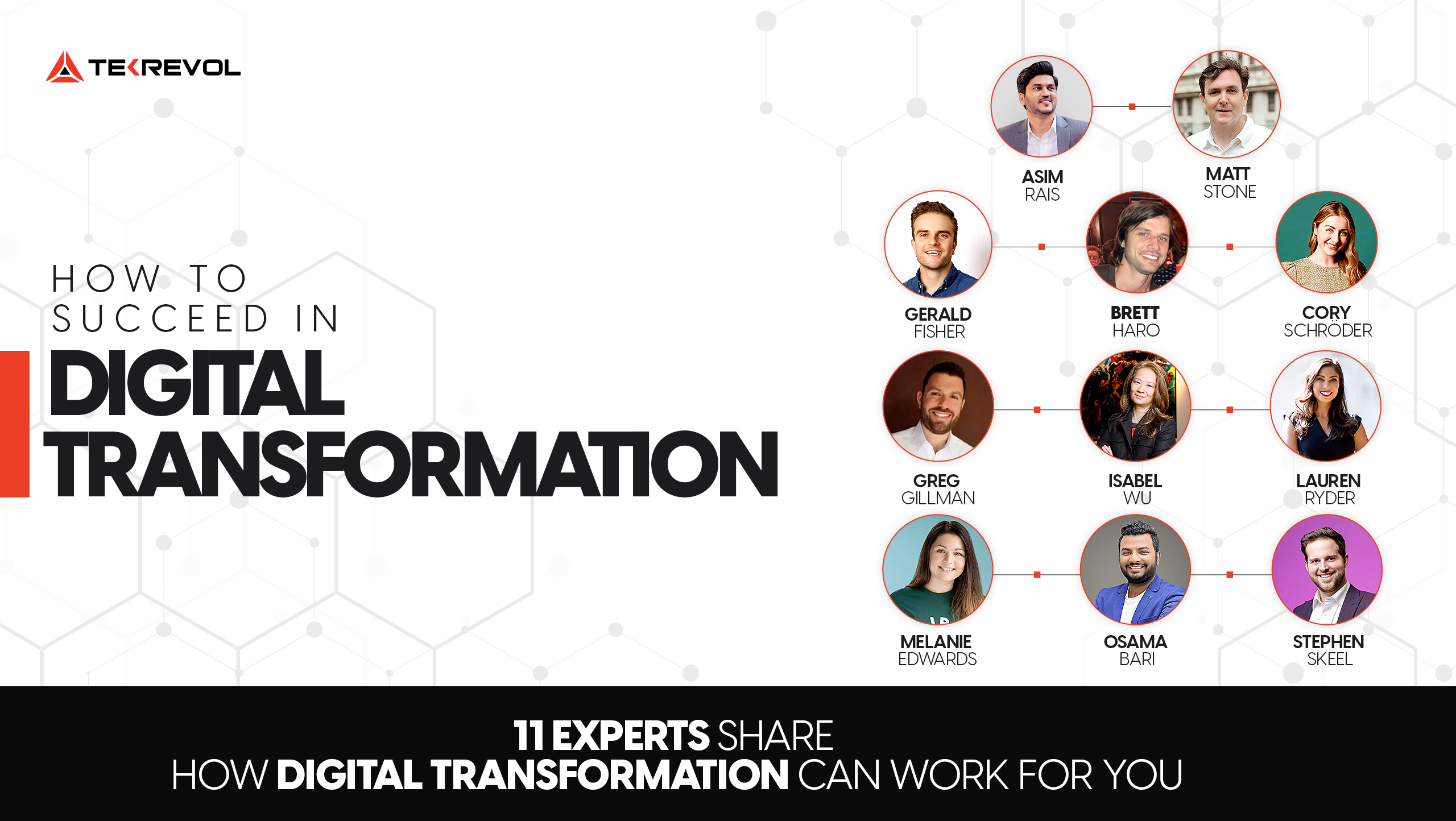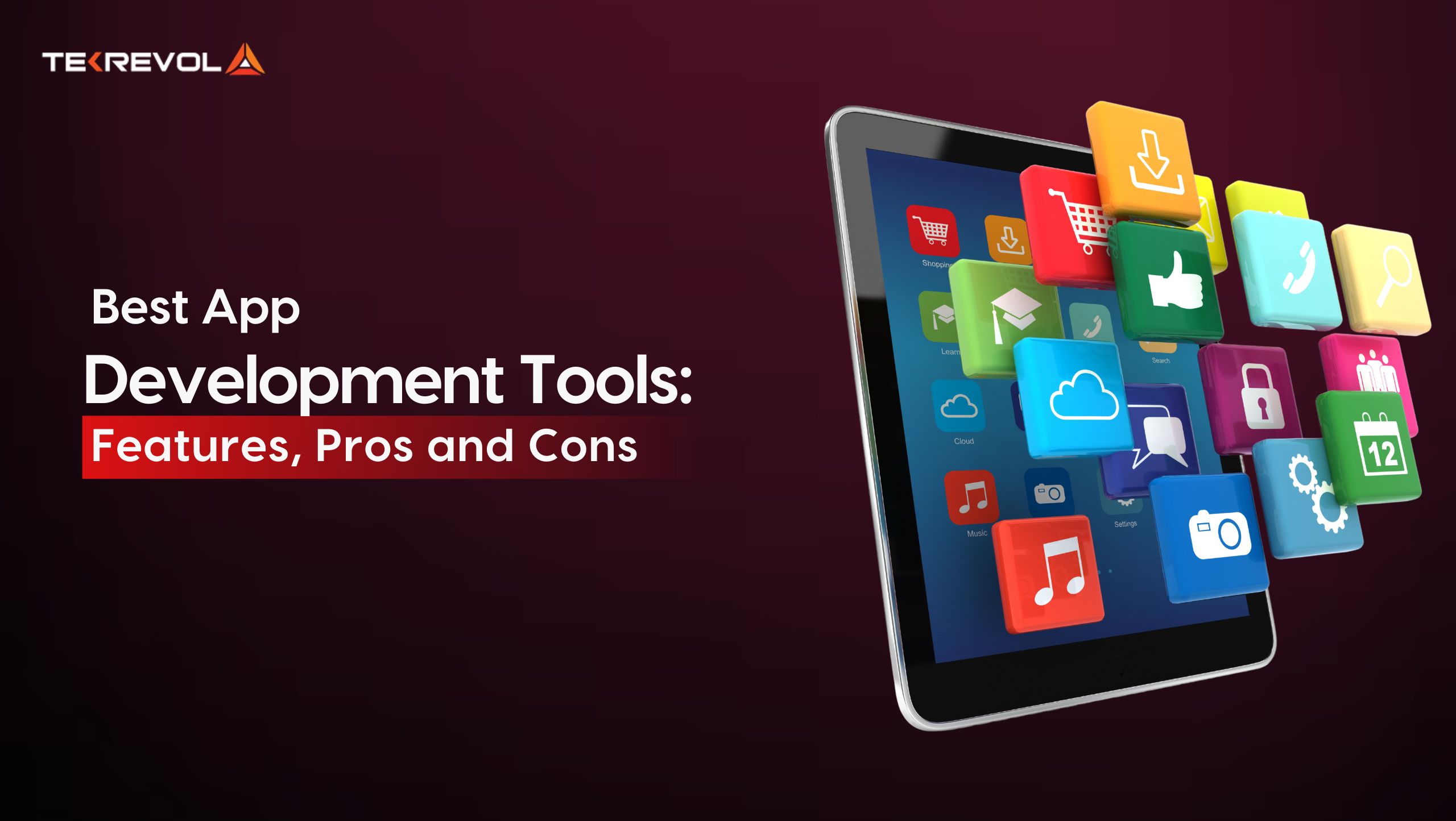The global digital transformation valuation will reach a staggering $1,247.5 billion by 2026. Moreover, various other statistics are available that signify the tremendous potential of the initiatives of cloud computing, data analytics, and governance, emerging technologies like Blockchain, IoT, Metaverse, NFTs, and more.
In this blog, we have compiled the responses of some of the top industry professionals, including our own Asim Rais, TekRevol’s Co-founder and CTO, on how to succeed in the digital transformation business.
How To Succeed In The Digital Industry
Focus on Communication, Change Management, and Continuity
- Asim Rais, Co-founder and CTO at TekRevol
Succeeding through digital transformation initiatives requires organizations to acquire and work through concrete principles.
Although every tech company’s goals and objectives differ, every digital transformation initiative starts by adhering to the 3Cs, communication, change management, and continuity.
Moreover, the human element is equally essential for any organization’s growth. Hence, you should always consider your front-line staff and encourage them to sell their vision to the leadership level.
Moreover, companies should collaborate with the right technology partners, understand and manage the power dynamics tagged with data, and communicate their short-and long-term goals.
Read more: The Keys To Succeed In The Digital Transformation
Focus on Brand Tracking Insights to Enhance Value
- Cory Schröder, Senior Content Marketing Manager at Latana
The goal of digital transformation should always be to improve a brand’s efficiency and value — which means companies should be selective when deciding whether or not to include new tools in their portfolios.
While some tools may claim many benefits, they only further complicate things. But a tool all marketers should consider using to deliver more value to consumers is brand tracking software.
With the ability to gather accurate, reliable consumer data, brand tracking custom software provides companies with insights into what their target audiences want and how they view their brand.
This allows companies to be far more efficient when planning their strategies — and to create content and craft products that are of more value to their target customers.
Removing the guesswork and providing data on critical KPIs like brand awareness, purchase drivers, and more — brand tracking tools will allow brands to become more innovative and successful in 2022 and beyond.
Stay On Top of the Trends
- Greg Gillman, Chief Revenue Officer at MuteSix
Part of succeeding through digital transformation is staying on top of what is needed to move the needle, making it critical to stay informed. There is no one-size-fits-all solution for success, as there are differences in everything from the health of your backend business to your customer’s shopping behaviors.
While it’s tempting to want to shake things up to stand out, brands need to remember to be strategic. Experimenting with the latest digital technologies, monitoring the competition and your industry, and then designing an informed strategy will provide the pathway for the smoothest transformation.
You can make your digital transformation a reality by keeping up with trends and constantly testing what works best for your audience.
Create and Distribute Engaging Content
- Stephen Skeel, Executive Producer and Co-Founder of 7Wonders
Strategy, content, and engagement! Having a clear content strategy that engages with your audience naturally is essential.
Content needs to be fresh and immediately recognizable in a saturated digital marketplace. Audiences are always looking for unique content that speaks to them. Represent your brand to build trust.
And most importantly, the audience wants to feel engaged, so polls and surveys can make them feel part of the process.
Be Fearless with a Top-down Overhaul
- Melanie Edwards, Sr. E-Commerce and Digital Product Manager at Olipop
To succeed through digital transformation, you need to understand your company will need a top-down overhaul. Now is not the time to implement changes slowly.
They must infiltrate your entire organization. A ramp-up period will depend on your business needs, but the digital transformation should eventually affect every department.
Make it an Organizational Re-set
- Isabel Wu, Transformation Specialist & Managing Director at MetaManagement
Ask many executives what “digital transformation” means and expect a broad-ranging response that variably covers technology upgrades, changing customer behaviors, new ways of working, futureproofing accelerating competition, and renewed strategic pushes. While all of these are true and necessary, they miss the essence of digital transformation.
Much of the issue lies in digital transformation, which logically can translate to “technology change and innovation.” It misses the actual core of a digital transformation: the organizational reset against new environments, expectations, and capabilities enabled by technology.
It is not “doing things differently” but “doing different things.” Thus, digital transformation’s failure rate remains between 70% and 94%.
Digital transformations are inherently tricky because they need to consider all the moving parts (people, processes, and problems) that make up the organization while driving toward the outcomes that ensure success (performance, growth, and equity goals).
While the executive considers the strategy (opportunities, solutions, and alignment), the workforce must adapt (competence, capacity, capabilities) to produce continuous value.

The missing piece in most digital transformations is not the lack of effort or investment. It is often the lack of a comprehensive and cohesive framework.
This lack makes it difficult to connect the vision and innovation desired to the day-to-day operations. It works against the advantages of multiple changes being pulled into a single concerted effort.
Using a digital transformation framework makes the concept tangible.
Technology Shifting Sands
-
Matthieu Stone, Chief Technology Officer at MyBond
Digital Transformation is one of those “buzzwords” that means different things to everyone you talk to. At the risk of being outed as a cynic, if someone tells you that they are on a “Digital Transformation” project, they might be on their way out.
So I’ll replace the word Digital with Technology for this piece. In that light, Technology has wholly transformed pretty much every business activity this century.
As I write this, almost 90% of MyBond’s customer interactions occur only via mobile phone. Our internal office is almost entirely paperless. Our product exists in the cloud, our back office in the cloud, and our telephone system in the cloud.
During the COVID lockdowns, we worked from our houses, and no office was required. We grew significantly month-on-month during this period.
This was not the result of a Digital Transformation project. We instinctively agreed on what was best for our customers and business and collectively made it happen.
We are not saddled with legacy technology or mindsets as a small scale-up. And yes, getting an agreement with a small team is comparatively easy. However, I would argue that if you are on a multi-year digital transformation project, your business might surrender a competitive advantage to a competitor like MyBond.
If your customer is at the center of your process, your company is constantly thinking about things that can be done better, faster, and cheaper. Lo-and-behold, you will constantly be in a state of improvement and change. This can only happen if the company leadership actively champions this vision.
Digital Transformation is about people, not just tech
-
Osama Bari, CTO at DIFX
For those in the tech industry, digitization is a buzzword thrown around often incorrectly. I see digital transformation as an inevitable process, it’s about organizations recognizing that digitization is more about people than technology, and the sooner that happens, the better. Trying to digitize successfully requires tools and strategies, and the right mindset.
As the CTO of DIFX, a centralized Blockchain exchange, I feel the pain of digitization even more because it is about integrating Blockchain into decades-old systems and organizations, which is no easy feat.
Merging traditional payment systems with Blockchain tech requires multiple considerations and paperwork. It certainly is not a plug-in option.
Additionally, digital transformation is held back by various factors like unclear business priorities, shortage of talent, lack of funding, and trying to one-size fits all solutions to every process or project.
Nevertheless, digitization always wins, no matter the slow speed or obstacles it faces. To me, successful digital transformation comes in bold leadership, the ability to lead and guide all teams across the organization through the change.
Secondly, organizations need to be enriched in adaptability & agility. Conforming & innovating with the trends of the industry is key to not being left behind and outdated. The exemplary leadership, along with this adaptability, is what makes holistic digital transformation possible.
Finally, the last step is the amount of talent & resources available. One thing companies need to do are train their existing employees to adapt and integrate into changing processes. This could be through training, retraining, or providing them with opportunities to learn and get certified.
Right now, various tech industries are facing a shortage of talent, and as tech professionals, we need to communicate properly about the various opportunities there are for people.
Cybersecurity, Blockchain, Machine Learning, AI, PayTech, etc., are all emerging fields that are rapidly developing and in need of talented individuals to join.
Transformation is like music; it has its own rhythm
- Gerald Fisher, Managing Director at Rumblr
Transformation, at its core, is like playing music. It has a rhythm and scale, and with different players, you need timing, a process, and invent and course correct. Yes, you’re helping your people, processes, and systems align with the organizational strategy, where you’re heading now and into the future – but it’s the same mentality.
It’s a people journey, just as digital is an enabler of change. Whether your objective is to centralize complex operations or scale into new markets with regulatory challenges, you need to identify early the high-friction and low-value touch points for your teams from day one.
Whether it’s a new CRM and compliance framework or a complete overhaul of your tech, the main objective in step one is to reduce the noise for the team while bringing your people along from the bottom up and top down and playing along at the same speed.
Like any team of 10 – or 20,000, the transformation process needs a clear digital and change roadmap, getting some wins on the board and building momentum internally while getting the house in order across tech, governance, compliance, systems, and processes. Building the operational rhythm, getting buy-in from the crowd, and being clear about what you’re playing together and the timing.
Empower Your People
- Lauren Ryder, CEO at Leading-edge-global
No matter what industry the organization is in, how extensive the digital transformation is, and how big/small the team is, the defining factor as to whether change is successful comes down to one thing: putting your people first.
Your employees are the lifeblood of your business, and any change you implement must involve them from beginning to end. Instead of looping in your employees at the end of the change process, getting them engaged from the beginning can make all the difference in the success of your project. Why? Because this is how you get your team on board with the changes instead of them feeling blindsided. By doing this, you create champions of change that will drive your transformation across the organization.
Focus on Data
-
Brett Haro, Founder & Director at Haro Helpers
Any digital transformation plan must include data because it powers the revolutionary insights that AI and machine learning can provide. Efforts to use these established technologies fail in the absence of that fuel. According to expert forecasts about the function of big data in 2020 and beyond, data is expected to only become more critical in the future.
Top companies across all sectors use data and analytics as competitive advantages, productivity boosters, and innovation engines. Companies with high levels of digital maturity report using data appropriately 88% of the time. Make discussions about data and analytics strategies a regular part of board meetings.
Conclusion
Staying competitive in the digital industry is about putting the right digital transformation initiatives through the right tech stacks, frameworks, and strategies to accomplish your organizational objectives.
As per the recommendations we gathered from some of the best experts in the IT business, companies should focus on communication, change management, and continuity, use brand tracking insights to create value, stay abreast of the changing trends, create and deliver engaging content, never hesitate for a top-down overhaul, push an organizational reset, and emphasize on your people, and not just technology.

 2079 Views
2079 Views October 19, 2022
October 19, 2022









